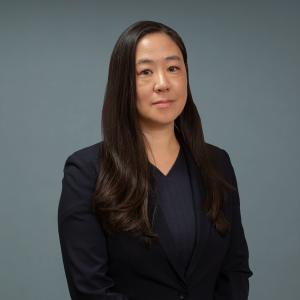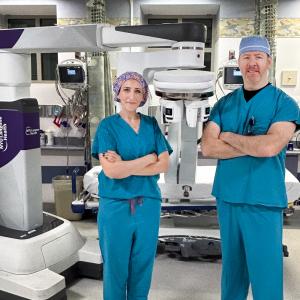
To support Stamp Out Cancer Brooklyn’s goal to raise awareness and prevent cancer in the borough, Dr. George Shahin, senior medical director of quality and safety for the Family Health Centers at NYU Langone, spoke with community members at the Red Hook Library.
Photo: NYU Langone Health
More than 2.6 million people live in Brooklyn, making it New York City’s largest borough—and the country’s fourth largest city. With 58 percent of its population representing minority communities, Brooklyn is also one of New York City’s most diverse boroughs. Brooklyn’s demographics offer healthcare providers a testing ground for strategies aimed at reducing cancer-related disparities and the overall burden of cancer.
Stamp Out Cancer Brooklyn, a multipronged, community-engaged initiative, aims to accomplish these goals. Spearheaded by NYU Langone Health’s Perlmutter Cancer Center and several other groups, the initiative engages trusted community stakeholders as partners to disseminate innovative, evidence-based solutions for cancer prevention, early detection, care, and survivorship.
“The success of Stamp Out Cancer Brooklyn depends on bringing together groups and individuals committed to addressing cancer disparities in Brooklyn,” says Benjamin G. Neel, MD, PhD, professor in the Department of Medicine and director of Perlmutter Cancer Center. “Stamp Out Cancer Brooklyn is a true partnership with NYU Langone Health, its Family Health Centers and Department of Population Health, and several local community health partners.”
Stamp Out Cancer Brooklyn is co-led by Chau Trinh-Shevrin, DrPH, professor in the Departments of Population Health and Medicine and associate director of community outreach and engagement at Perlmutter Cancer Center, and Simona C. Kwon, DrPH, MPH, associate professor in the Department of Population Health. Victoria Foster, MPH, program manager at Perlmutter Cancer Center, serves as manager of the initiative.
“One of the most important aspects of Stamp Out Cancer Brooklyn is the focus on Brooklyn, which we believe is a microcosm of the broader world given its diversity,” says initiative member Joseph E. Ravenell, MD, associate professor in the Departments of Population Health and Medicine and co-leader of Perlmutter Cancer Center’s Community Outreach and Engagement Program. “The initiative allows us to connect what we are doing in our laboratories and in our clinical settings to what is happening in the community.”
Stamp Out Cancer Brooklyn centers around cancer prevention, with an emphasis on obesity, tobacco cessation, vaccination against and treatment for infection-related cancers, and early cancer detection. Efforts focus on reducing the major cancer burdens that stem from breast, colorectal, lung, and prostate cancers as well as unique and preventable infection-related cancer disparities. Brooklyn’s young population—87 percent of its residents are under the age of 65—represents an opportunity to bend the cancer disparities curve through programs aimed at prevention and early detection.
NCI Funding Addresses HPV Vaccine Hesitancy, Obesity in Immigrant Communities
Several programs are currently underway or in the early stages of planning, targeting various ethnic communities in Brooklyn, including Chinese, Arab, Bangladeshi, and Mexican Americans as well as the Russian-speaking community.
For example, a National Cancer Institute (NCI)–funded project, called Vaccine Acceptance in Immigrant Youth and Adolescents (VAIYA), will apply health communications and community-based participatory research approaches to identify the many factors that contribute to human papillomavirus (HPV) vaccine hesitancy as well as identifying the strengths and resources to build a sustainable infrastructure to deliver health promotion information in a community-centered way in the Mexican American communities in Bay Ridge and parts of Sunset Park. The overall goal is to develop a social marketing campaign to provide a message about HPV vaccine in a way that is meaningful to the community.
“One of the things that we are finding is that because these are communities with high levels of limited English proficiency, language access is a big factor contributing to low vaccination rates. Existing campaigns are not translated and are not reaching these communities,” Dr. Kwon says. “We want to ensure that we create a campaign that is multilevel and focuses on gatekeeper community leaders and the healthcare providers who serve the community, as well as community members.”
Another NCI-funded project, called FORTIFY (Focus on Obesity Reduction and Tools for Immigrant Families and Youth), aims to address obesity and identify feasible and sustainable ways to improve lifestyle behaviors in Mexican and Chinese youth in Sunset Park. Using a methodology called group model building, community partners share their expertise about the local community and existing assets, which enables researchers to produce a visual map of all the players and considerations for feasible and sustainable program implementation.
A Focus on Nutrition and Food Availability
Another Stamp Out Cancer Brooklyn program focuses on multigenerational nutrition education in the Chinese American community, and has plans to expand to the Mexican and Central American communities this spring. Ultimately, the program will include Arab American and Russian-speaking immigrant populations as well.
“We understand that offering nutrition education itself is not enough. We need to ensure that the food is culturally appropriate, cost effective, and appealing,” says Ms. Foster. “It isn’t helpful to tell someone who doesn’t know what an eggplant is how to cook an eggplant.”
The team also examined food scarcity in immigrant neighborhoods during the coronavirus disease (COVID-19) pandemic to evaluate the impact of closures of fresh fruit and vegetable vendors. They selected six New York City neighborhoods in Manhattan and Brooklyn for analysis, including two socio-economically advantaged neighborhoods (Upper East Side and Park Slope), two socio- economically disadvantaged neighborhoods (East Harlem and Brownsville), and two ethnically Chinese neighborhoods (Chinatown and Sunset Park). For each neighborhood, satellite imagery was used to virtually walk down each street and identify fresh fruit and vegetable vendors that were open and active in 2019. The group found that restaurants, grocery stores, and fruit and vegetable vendors were disproportionately affected in the Chinatowns even though there were no outsized rates of coronavirus there.
Meeting Community Needs
With its emphasis on community-based participatory research, Stamp Out Cancer Brooklyn collaborates with the most trusted organizations and individuals in the community, such as social services or faith-based groups. Stamp Out Cancer Brooklyn works across NYU Langone Health’s network in Brooklyn, including the social services, patient relations and intergovernmental affairs departments of the Family Health Centers at NYU Langone.
During the COVID-19 pandemic, Stamp Out Cancer Brooklyn has conducted a series of community-facing virtual information sessions, presented in the language appropriate to the community. Clinicians attend to enable community members who might not be connected to a healthcare system have the opportunity to ask questions. A representative from a community or faith-based organization acts as moderator so that there is not just a clinical presence. A recent session focused on COVID-19 vaccine information, but subjects have ranged from parenting during the pandemic, liver health and COVID-19, smoking and COVID-19, and going back to school during the pandemic.
“Stamp Out Cancer Brooklyn, with its relationships with community-based organizations and other stakeholders, is a vehicle for us to connect to our communities, not only to disseminate new discoveries and technologies related to cancer, but also for us to be able to hear and understand what is most important to them,” Dr. Ravenell says. “Stamp Out Cancer Brooklyn allows that kind of bi-directional conduit so that we are serving the community’s needs from a public health perspective as well as making sure that we prioritize what they perceive as important.”

